
The Great Bhutan Bike Journal | Kim’s Journal
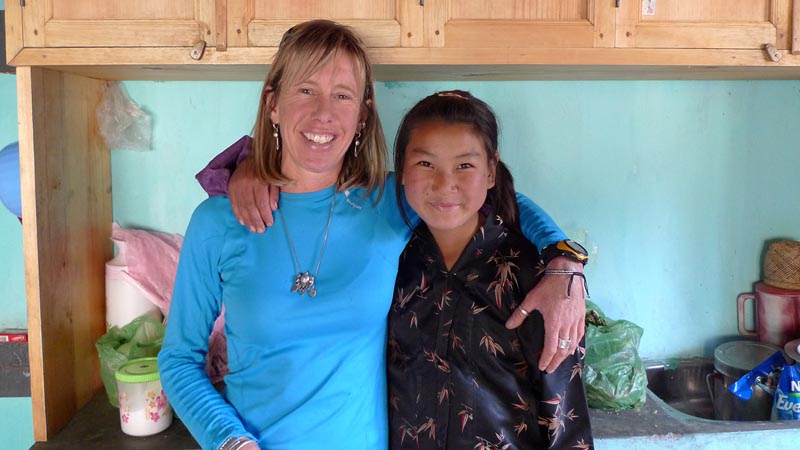
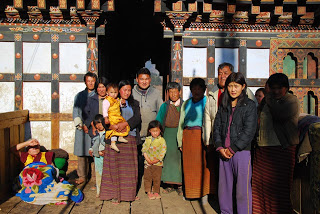
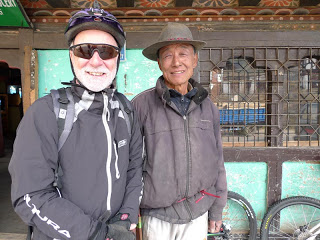
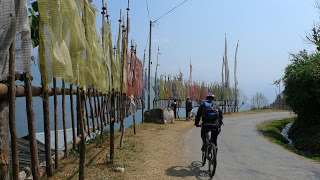
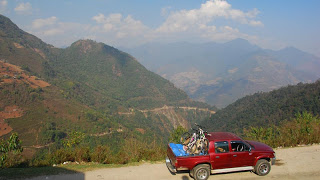
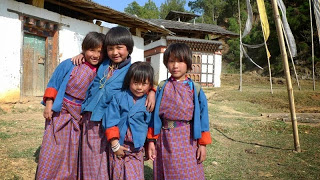
DAY 1
After a two hour delay in Kathmandu, we finally boarded the Druk Air flight to Paro, Bhutan. The flight was spectacular, passing by Nuptse, Lhotse and Everest, Makalu and other Himalayan peaks and the descent into the Paro valley terrifying as the captain maneuvered our jet down through the narrow, steep-sided valleys, seeming to barely miss the forested walls on either side. The flight was full of Bhutanese who screamed each time the plane dropped and was tossed back up in the air; I gripped the seat in front of me with white knuckles, praying my next incarnation would be a good one …
But we landed relatively smoothly in Paro, the skies bright blue and the temperature dry, in the high 60s; a perfect day. We met our guide Karma and driver Tsering, loaded up our red pick-up and drove the few kilometers to Paro, were we had lunch at a small restaurant. Bhutanese fare is delicious if you like meat and chilis. Their national dish is ema dates, whole red or green chilis cooked with butter and cheese and served over rice. Delicious. As a tourist you’re fed far too many dishes, and we barely made a dent in the ema datsi, chicken, potatoes and cheese, cauliflower and cheese, Chinese vegetables and Bhutanese vegetables. Phew! We drove the few kilometers to the Tenzinling Resort, a wonderful new hotel just outside of Paro. The rooms here were my favorite, large with high roofs and large windows, really one of the nicest hotels I’ve stayed in for ages.
After lunch we fixed up the bikes and headed out for an afternoon ride. Leaving central Paro, a much more traditional town than the capital Thimpu, we passed the row of whimsically painted general stores heading out of town, turned steeply up an un-paved street, and reached our amazing hotel, Tenzinling, brand new and much more class and luxury than I’m used to! The rooms were magnificent, all windows in front and overlooking the houses of the Paro suburbs and the massive Paro Dzong in the distance. We were the only clients at the hotel as it was February, which was nice. We put together our bikes (mine borrowed from X-plore) and set off towards Drukyel Dzong some 10 km up the valley. We chatted with lots of smiling kids speaking good English along the way, a few wanting to ride my bike, unsuccessfully. Apparently brakes aren’t in the same place on kid’s bikes! And all the kids wanted their photos taken, which was fun. After wandering around the ruins of Drukyel Dzong, perched picturesquely above this green valley packed with intricately decorated Bhutanese houses, we cycled back along the same route, stopping to take photos of the dramatically situated Taksang Gompa, or Tiger’s nest, one of the ubiquitous Guru Rimpoche’s haunts back in the 8th century. For dinner we met the owner of the company we used for the trip, Ugyen Dorji of X-plore Bhutan, who came down from Paro an hour’s drive away.
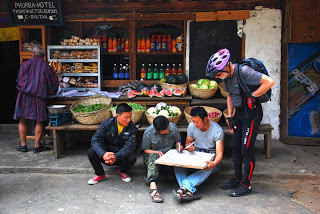
DAY 2
We awoke to bright sunlight streaming into the rooms, but soon the clouds covered it and the temperature dropped. It was hard to hold my GPS in my bare hands just before breakfast at 8:00 to take a reading it was so cold. But it warmed up a bit by 9:00 or so when we jumped into the pickup. We had a lovely but slightly grueling ride to Haa, from about 30 km past Paro, at Chuzong, the confluence of two rivers, the Paro Chu and the Thimphu Chu. The first hour was an easy but steady uphill along an elevated trail high above the Paro Chu. My bike chain doubled up about an hour into the ride, and we changed my wheel at Dawakha with the spare that we fortunately had in the pickup. More up for another hour and a half until lunch, where we picnicked at a beautiful spot on a ridge, lined with ‘chador’, or white prayer flags erected as a memorial for someone when they die. The ridges were full of ‘lha khang’, or small Buddhist gompas, whitewashed with gilded spires. Below, the villages clung to the steep hillsides and the terraced fields of barley, millet, buckwheat and winter wheat slanted steeply down to the river. Soon afterwards we stopped to visit with some Bhutanese on the side of the road, school kids just about to return to their classes.
An hour and a half after lunch we stopped at a lovely Bhutanese-styled tea-house with a warm wood fire burning inside; the weather had turned a bit cold and grey, and we were happy for the break from the wind. I took wonderful photos of older Bhutanese dressed in their traditional ‘ghos’ and ‘kiras’, the women with short hair and bangs, and the men with Western hats. The lively villages, all of them painted with fantastic murals of Bhuddist animals, phalluses (representing the Divine Madman Drukpa Kinleyand ornately-decorated windows an sidings, are bordered with fences along the narrow roads, and stray cats and dogs wander throughout. I jumped into the pickup just before Jyenkhana and drove the rest of the way, while John biked about 15 km further downhill, the end in the rain. We stayed at a lovely, slightly rustic hotel called Risum Guest House, where they lit a hot fire for us in the bukhari, a common feature in Bhutanese homes and hotels.
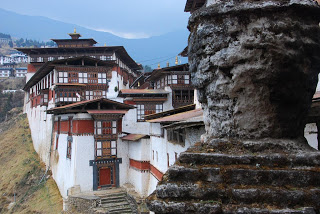
DAY 3
We woke up to a picturesque, bucolic Bhutanese valley covered in snow this morning. Yesterday, about 20 km from Haa village to the northwest of Paro, the weather turned grey, a few raindrops fell, and we were soon back in the pick-up driving in a light snow to our lodge. By the time we had arrived the snow was quite heavy and had accumulated. They had a wood-fire going in the dining area, so I sat cozily around it until my ‘geezer’ was hot, an hour later, for a shower. We had a lovely 15 km each way bike ride the next morning, cold fingers when we left the guest house just after 9, so we stopped to chat with the locals in Haa village and then to watch an archery match between Haa and Paro archers, with singing and dancing Tibetan style when someone hit the target. The road was paved out to the end of the valley where the army had a checkpost blocking further explorations, even in sections covered with slick snow and ice. Lots of photography in this idyllic setting, traditional Bhutanese houses providing the foreground for snow-covered peaks and pine forests in back.
After tea back in Haa, we drove the route back to the lunch spot, from where John cruised down a long downhill stretch in the rain back to the confluence at Chhuzom. From there we drove along the main ‘highway’ for 31 kilometers to Thimphu, the last five along a double laned highway, a change from the rest of bucolic Bhutan. We arrived late in the afternoon, just in time to check into Hotel Galingha, shower and head out to buy SIM cards and have a quick visit to the new Thimphu market, not nearly as atmospheric as the old market in the field, do a bit of quick shopping. We had dinner with Ugyen again at Karma’s sister’s hotel, empty at this time of year.
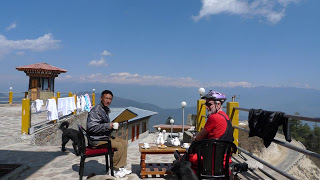
DAY 4
Driving about 5 km out of Thimpu to avoid the traffic, we started right up the Dochu Lo, one of Bhutan’s most scenic passes overlooking it’s hight snow peaks bordering Tibet at 3140 meters. I enjoyed this climb, only having to pedal from a pack of dogs one time. Fortunately our jeep was just around the next corner and the dogs turned back. It’s the only scare I had with dogs in Bhutan. I stopped to take some photos with village kids at a small village, met some Tibetan woman selling apples (from China) at a roadside stall, passes a checkpost and then continued through hillsides of oak, maple and blue pine the the pass. I’d been there years before and remembered the prayer flags, but the Dochu La is now transformed with 108 new chortens, beautiful examples of Bhutanese Buddhist architecture, as foreground for the Bhutan Himalaya in the background. Gangkhar Puensum (3541 m) is the highest peak totally inside of Bhutan.The chortens were built in 2005 as a memorial for the Bhutanse who lost their lives in the Assam conflict. There was a large puja on the adjoining hilltop, with incense burning, drums and cymbals. Many people were circling the 108 chortens and adding fresh whitewash to the massive, square-based one in the center of the complex.
We stopped just below the pass for tea at a large tourist restaurant overlooking this magnificent scene, and then continued the amazing 42 kilometer ascent to Metshina. The forest heading down is filled with rhododendron, alder, cypress, hemlock and fir, and the damaged road switchbacks relentlessly, or so it seemed on my bike with bad shocks. John, of course, loved the long, long downhill and raced a Bhutanese biker down part of it. The lovely valleys opened up behind us, green with crops and fruit groves and dotted with white Bhutanese houses. As we descended, our cold and wind gear was quickly shed and we reached a more tropical region of Bhutan as we cycled through bamboo forests, the small road lined with prickly cactus. We passed through a small village and then finally reached Metshina where we lunched at one of the nicest restaurants of the trip, overlooking this magical valley. The last 10 or 11 kilometers to Punakha were wonderful, cruising along a paved road, mostly down but with undulating small hills. We checked into the lovely Damchen Resort right on the Mo Chu (Punakha sits at the intersection of the Mo Chu and the Phu Chu, the mother and father rivers) and headed out on our bikes to Punakha Dzong, enjoying the rest of the balmy, tropical day on our bikes. Punakha Dzong is perhaps the most impressive of Bhutan’s dzongs, the second one built and the seat of the government until the 1950s. The afternoon light was perfect, illuminating the guilder rooftops.
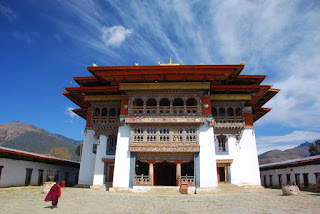
DAY 5
We had a wonderful day today, first cycling about 15 km up the valley along the Mo Chu to Ugyen’s new kayaking and rafting resort along the river, soon to be a fantastic stopping off point for a few days of relaxation and river activities. En route we watched the black great cormorants sunning themselves on rounded river rocks and vivid blue kingfishers darting about. After touring the tropical complex, we cycled back and had a tour of Punakha Dzong, followed by lunch along the riverbanks. A huge, dead tree branch pummeled the ground just to the dzong side of us, scaring the villagers and grazing cows as well as us! After lunch we set out on two separate excursions, John’s (with Tsering) along a precipitous off-road trail on the western banks of the Pho Chu and mine crossing the Pho Chu and continuing along the small, sandy road to the suspension bridge about 10 or 15 km past the turnoff. Right after crossing my first bridge I continued cycling uphill along a rutted trail for a bit to take a look at the small village just above, soon afterwards backtracking back down to the ‘main’ road, stopping often to chat with locals, most of whom spoke Nepali. The guys & I missed each other at the bridge (there were two, and I was cycling between the two) but I had a nice ride back with a cool afternoon breeze, finally crossing the road from the new part of Punakha, called Kuruthang, right to our hotel.
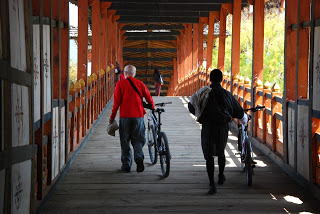
DAYS 6 & 7
We had a lovely, flat morning cycle along the Punatsang Chu, flat, calm and reflecting the Bhutanese architecture on this windless morning. We followed the bypass road, reached Wandgue Phodgrang about 7 km later and had a walk around this historic dzong, not as restored or as large as the Punaka Dzong but beautiful with its traditional murals. From the dozing, perched on a hill, we pedaled downhill, passed all the time by large trucks as there is roadwork and a ‘timing’ system along this road. The day grew hotter as we descended, the landscape becoming more tropical and resembling Nepal more and more. We met the jeep past Chuzomsa where there is an In-trek Hotel, at a small local shop in the hamlet of Tigizampa, about 10 km past Wangdue. We drove past the roadwork and had a lovely lunch at Nobding, perhaps the best food of the journey, about 17 kilometers below the Lawa La pass. The ride up and over the pass was grueling, becoming more steep towards the top of the pass. I was ready to give up part way up but Karma told me it was only three kilometers more; and what a three kilometer ride it was! I threw my bike into the back of the pickup at the Lawa La, cold and totally spent, and rode all the way down the pass to Pobjikha. John cycled the great downhill with Tsering.
We stopped to look at a beautiful Bhutanese house divided in two, with a porch in front connecting the two. An extended family and Lama were enjoying the afternoon sun on the deck, and I stopped to take a photo of the beautiful house and setting. It turned out that Karma knew the family and they invited us up. The Lama was having a puja for a young girl (the neighbor’s, we’re not sure if it was a relative) who had some disabilities. We spent some time outside with the family and then went inside to the common room around the fire for an hour afterwards. The Lama had the seat of honor in front of the fire with his back propped up against the far wall. A very young Rimpoche, perhaps two years old, dressed in gold and yellow, was the son of one of the families and ran around the large room chasing a yellow ball …
We stayed for the next two nights at a fantastic hotel called Dewachen. The rooms were huge with their own stoves, traditionally decorated in a rustic style, and the dining room was lively with an enormous bukhari stove to sit around. We met an English man and his Burmese wife with their Australian designer who were building a hotel just above the village, near Gangtey Lhakhang, so had an interesting evening of drinking beers and sharing stories around the fire. The next night a friend from Kathmandu, Richard Bull, showed up, doing some research for Encounter Himalaya, a local Kathmandu trekking and rafting company (the first one I trekked with).
The next morning we drove up to pay a visit to the Amankora Resort ($1300 per night, not including meals or spa) about 3 kilometers up the valley in the direction of yesterday’s pass. A nice Bhutanese girl showed us around, and although it was nice and was meant to mirror the environment, we found it a bit too minimalistic and worth perhaps $300 a night. Anyways, it was interesting to see; no photos allowed, but tried to visualize the details that were nice. We continued about 5 kilometers up the pass road and visited Gangtey Gompa, the first Nyimgmapa temple built in 1613 by the grandson and reincarnation of Pema Lingpa and the rest built by the next reincarnation. The gompa is spectacularly set, overlooking the glacial Pobjikha Valley and its endangered black necked cranes who spend the winter in this valley feasting on the dwarf rhododendron which grows in the swampy glacial soil. The cranes are supposed to circle the gompa three times before setting off on their hazardous journey to Tibet for the summer, and in fact three small groups of cranes did so when were were visiting the gompa! We hiked down on a marked Nature Trail, circling the cranes on the other side of the valley, and getting a few good photos of them taking off and landing nearby. We had lunch at a local restaurant and then returned to the hotel briefly before jumping onto our bikes for a bumpy ride to the village about 5 kilometers down the valley. Just before reaching the hotel I stopped at a General Store (cum Bar) where a few local met where fairly inebriated, and met a nice Nepali woman and her young daughter, who hardly spoke but giggled quietly when I spoke Nepali …
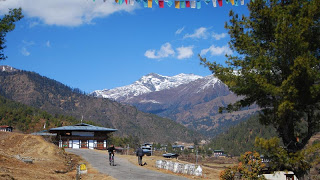
DAY 8
I left the hotel a bit early and cycled up to Gangey Lhakhang, about a half an hour’s gentle ride uphill towards the pass. Descending from our hotel, the small country road passes several small shops and houses, and then climbs past the Amankora Resort, afterwards winding through open forests of pine and fir. The pickup met me about 4 or 5 km from the Lawa La pass, where yaks grazed by the whitewashed square chorten. We cycled the 3 km to the next pass, the Pele La, about 100 meters higher than the Lawa La, although I had to throw my bike in the back of the pickup as my chain was sticking again. We cleaned the bike at the top of the pass and it was OK. Cruised down the pass on a narrow but good road, almost car-free, freezing cold. Stopped to buy a few baskets close to the bottom, and then continued about 5 km more to the beautifully set Chendebji Chorten, surrounded by white prayer flags on long poles. This is a Nepali-style chorten, whitewashed with a rounded dome and Buddha eyes. We had lunch nearby and then continued on a lovely, nearly flat ride for about another 10 km. The temperature was perfect and we enjoyed our ride at just under 2500 meters as the road wound its way through idyllic Bhutanese countryside. We passed a small gompa with monks in front – Tashi Choboling? – which might be the center of the country. Tsering told me this, Karma said it was Trongsa.
A further 20 km or so of cruising downhill on this rural road, now becoming more wooded, brought us to a viewpoint of Trongsa Dzong, the oldest in the country, built in the 16th century. We decided to continue on, and had a seriously fast and windy downhill, lots of fun, to the bridge from where it was a 5 km ride more uphill to Trongsa. We spent some time at this wonderfully atmospheric dzong, where monks wandered in and out feeding the pigeons and going about their day, watched over by the ‘disciplinary monk’, a throwback to olden days. It was an hour plus drive through grey, rainy weather with snow at the highest reached to go over the Yotong La, 3425 meters. 11 km down through lovely pine and fir forests lined with dwarf rhododendrons brought us to Chhume, where we spent the night at the charming Chhume Nature Resort.
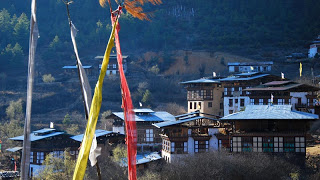
DAY 9
Woke to a misty Bhumtang landscape this morning, the wide valley opening up before us and brightening with the first morning’s rays. We spent a good part of the morning meandering through the idyllic country lanes fences in pine (actually some the major east-west highway in Bhutan), stopping to look at textiles at a tourist center. There, we were approached by a van full of Brazilians making a documentary on Bhutan, and asked to be the ‘local talent’, biking with bike-cams past the cameraman. Quite amusing. Even had an interview … Invested in an exquisite Bhutanese silk scarf.
We had an easy climb to the Kiki La (pass), adorned with colorful prayer flags on long, erect poles and then a long, winding descent down to the second valley in Bumthang, finally along the Jakar Rong Chu, where we stayed at the Wangdicholing Resort, owned by Karma’s younger sister, a few kilometers before the main town of Jakar. Jakar has had two fires in the past year, so is presently under reconstruction, but there are still enough shops open to get the feel of it. We had lunch at our table in front of a hot bukhari stove, and after digesting a bit John & I took an easy ride into town and then further up the western valley, stopping at another Nepali shop where John made the young girl cry. The weather turned cold and rain started to fall so we turned back and had a cozy afternoon in our rooms, with blazing fires, enjoying the chance to catch up on emails (the first wireless/internet in about five days) and edit photos in our rooms. We met an Indian woman from WHO in the evening and had a lively discussion about organic vs normal agricultural practices, with John spiritedly on the side of non-organic farming.
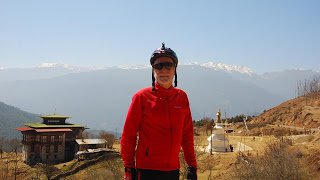
DAY 10
We woke to a slightly less grey morning although light clouds filled the valley and gave it an ashy tinge. We parked the bikes and had a real morning of sightseeing in the owner’s car. The majestic Jakar Dzong, built in 1549, was first on this mornings sightseeing agenda. Next was the ancient and atmospheric Jampey Lhakhang, built it 659 by King Songsten Gampo on the same day as Kyichu Gompa in Paro in order to pin down the body of a Tibetan demoness. Here we saw more older Bhutanese doing ‘koras’ and counting their prayer beads than we have seen anywhere else. Next to the wonderful Kurjey Lhakhang, of which the oldest temple was built in 1652. The next temple was built in 1900 by Sanpa Lhundrup, the first king of Bhutan, and the last in 1984 by the queen mother, Ashi Kesang Wangchuck. The second temple was built over a cave with the body print of Guru Rimpoche (where I lit a butter lamp), so a sacred spot. Finally, we returned to the town, crossed the bridge and headed about 7 kilometers up the eastern valley to visit Tampshing Lhakhang, built in 1501 by Pema Lingpa. Enough for one morning!
After lunch, John & I headed back to the same Tampshing Lhakhang along the lovely country road, and on the way back were invited into a new house by a 13 year old girl named Sonam. We later met her younger half sister. Apparently Sonam’s real father had left when she was young, which is becoming quite common now in Bhutan sadly. We stopped and peeked into the Red Panda brewery en route back, and then bought some delicious Guda cheese at the local dairy shop. A Swiss man was the force behind both the beer and the cheese. Local apple juice and apple brandy were also available, the juice being just like the local Manali apple juice.
Stopped in town to do a bit of shopping and met some Tibetan families, descended from parents who fled Tibet in 1959. We’ve met a few Tibetans in Bhutan, and apparently there are many living here now, not quite as integrated as the Nepalis but getting there. Took a look at a somewhat sad crafts and textile shop and then headed back to the hotel as it had turned cold.

DAY 11
A great day today except for this awful hotel in Mongar; I awoke this morning realizing how truly special the rest of Bhutan is, un Indian-hotelized, with out traffic and noise pollution … We left beautiful Jakar valley a bit late as we had to change the body of my bike. We couldn’t fix the chain problem. So the body from the extra bike worked fine. We finally got going at 9:30, and hour past what we had tried for, an cycled back over yesterday’s bridge, turning right. The first 10 kilometers were perfect cycling along the Chamkhar Chu (?), eventually starting to climb gradually past fenced farmhouses, potato fields, cows and local Bhutanese out around the houses. Higher up, perhaps 20 kilometers into the ride, we were high above the valley and snow peaks opened up around us to the front, right and back (the left was a cliff), just spectacular. Soon we passed several groups of white prayer flags When we had cycled about 26 kilometers we reached the lovely and scenic village of Tangsibi at about 3000 meters. Here, Ugyen’s father in law built a wonderful white chorten between his house, now empty, and the road. Villager circumambulated this chorten even though it was a small circuit.
From here we jumped into the jeep as we had about 200 kilometers to cover, which would take 7+ hours in a jeep, and drove the rest of the way, now past rhododendrons, to the Shertung La (3590m), another pass peppered with leftover snow. Back on the bikes, we cruised down the pass for a short time passing the idyllic village of Ura, with its gompa backing the closely packed houses, and then cycled up along another dramatic and traffic-free narrow road for another 6 or 7 kilometers. We again jumped into the pickup and wound our way up and up for a long way to the Thrumshing La, the highest pass in Bhutan at 875o meters. For the last 5 kilometers or so were shrouded eerily in fog, and the same on the opposite side of the pass, the heavy fog almost totally obscuring the road.
We drove for much of the way down the pass; John jumped out about 68 kilometers before Mongar and started the fantastic descent, but it was still too nerve-racking for me, so I waited another 10 kilometers or so to join him, when the valley opened just a little bit and the drop wasn’t straight down. The weather was much warmer as we dropped below 2000 meters, and the descent great as we wound out way high over the terraced fields, houses and prayer flags far below us. The scenery was just like the Arun Salpa valley in Nepal, with a river far below and fruit trees and terraced fields, simpler houses and animals covering the landscape. We were 30 kilometers from Mongar when we reached a road-block (road building timing) which was slated to open in an hour, at 6:30. We found a woman selling dried, salted banana and pomellos, and a small shop/bar next door, so went to have a beer and talk with the villagers who spoke perfect Nepali. The rest of the ride, uphill to just above 1600 meters from about 700 meters, was in the dark but we could see the many lights of Mongar, large town, scattered over the hillside. Hotel terrible but we’re headed further east today so all is good!
DAY 12
A nice morning for a ride we head all the way to Tashigang, some 95 kilometers from Mongar, nearly as far east as you can go in Bhutan. It’s the first day we started on time and in a short-sleeve shirt, which I appreciated on the 18 kilometer ride up the Kori La at 2380 meters, not too steep but continuous, an 800 meter climb from Mongar. The countryside was still misty, the colors of the terraced fields mutes, as we paddled up.We stopped at a flash of crimson, a wild cherry tree covered in chatty warblers feeling upside-down on the flowers, and saw a kestrel chasing an eagle over a valley covered in white flowering daphne and red rhododendrons. From the top we had a fantastic 21 kilometer downhill through pine forests to the quaint village of Yadhi, at 1480 meters, where we stopped for tea at a traditionally-styled teahouse, with a sunny courtyard and dried chilis and tiny tomatoes. Beyond Yadhi we continued our descent, the many tight swithbacks called the ‘Yadhi Loops’, finally reaching the riverside 350 meters and 10 kilometers later. We’d dropped down to 650 meters and it was hot and humid. Crossing a bridge over the Shere Chhu at 1:30 in the heat of the day, we then had a scorchingly hot 200 meter ascent on a fantastic cliff-side road over the river, reminiscent of the Arun Salpa Valley, which seemed to never stop climbing. About an hour later, dropping with heat exhaustion, we dropped back down to Rolong for lunch. This was our first real local-styled lunch, sitting outside under a thatched roof with the river breeze barely cooling us, wonderful, very reminiscent of Nepal or India.
We continued after lunch on a ‘flat’ road to the bridge at Chazam at just over 700 meters, from where we could look straight up the ridge to Trashigang Dzong, and then had a last grueling 10 kilometer, approximately 400 meter climb against the headwinds, stopping for sweet mango juice for energy every few kilometers. Only a kilometer before Trashigang we reached another road building timing block, and sat for 45 minutes looking right out at the dzong. Finally at 5:00 the bikes we permitted through the roadblock and we wound our way through the bulldozers and cars and trucks lined up on the other side to the tiny, medieval feeling village of Trashigang, perched precariously along the steep hillside. It’s an atmospheric village of small Indian-styled shops and small hotels crunched together around a small square with a prayer wheel in the center. Our hotel, the Drukdeothjung, is on the basic side but with some character, much better than last night’s grovel. We dined outside in a simple courtyard with big, leafy trees providing our canopy, a lovely evening.
DAY 13
We had a much easier day of cycling today, but first, after breakfast outside, a visit to the Trashigang Dzong, which only had one courtyard, different than most dzongs which have three. We arrived as the bureaucrats entered the building for a day of work, and looked down on the road to Tashi Yangze and from Mongar. At 10:00 when the road opened we cruised the 10 kilometers down to Chazam, from where we turned right and headed on a good road, going slightly uphill most of the time with a spectacular cliff-side section, for 13 kilometers to Gom Kora. Gom(pho) Kora is a brightly painted gompa sitting right on the river, another spot where Guru Rimpoche left his head and body prints, and today the monks from Tashigang were continuing a yearly puja so the gimp was livelier and more colorful than usual. We watched the puja for a bit and then walked the okra around the smooth rock where GR meditated. Men tried to carry a smooth, heavy rock around the kora and sqeeze through a small gap leaving GR’s cave and entering the kora a few meters ahead. They were having better luck with the rock …
We cycled two more kilometers to reach Duksom at 860 meters, from where we decided to take the pickup half way up the 30+ kilometer, 900 meter ascent to Trashi Yangtse. I was still feeling a bit of heat exhastion from yesterday, having already downed a few rehydration packets, and today was hotter than yesterday. We had tea and wonderful watermelon at a cute teahouse (cum shop/vegetable and fruit market), which turned out to be owned by Karma’s relatives, a discovery for him. After driving just over 10 kilometers up a windy, narrow road hugging the steep hillside, we stopped for lunch at a chorten with 5 colored prayer flags on vertical poles, a perfect spot. We tried to cycle to Trashi Yangse from here but John was stung under his helmet by a bee, and I cycled about 3 treacherous kilometers ahead, nearly being pushed off the cliff several times by passing trucks and cars (although this should have been a traffic-free road) and had develloped an incredible headache, again from the remnants of heat exhaustion yesterday, so happily jumped into the jeep with John when it passed. The road continued in the same manner, higher than before so I was grateful for the jeep passing; 18 white-knuckle kilometers later we reached Chorten Kora just on the outskirts of Tashi Yangze. This beautiful chorten was modelled on Boudhanath in Kathmandu, carved on a radish and brought back in a slightly shrunk state to Bhutan where the new chorten was constructed in 1740. We stayed at the lovely Karmaling Hotel looking down over the town, with no French tourists (or any others) in sight. I took a walk around town in the afternoon, and nothing much happens here, there’s not even much of a town center, but it’s a much larger village than you would expect for such a remote outpost. Dinner by a fire upstairs next to the rooms, with no one around …
DAY 14
It was overcast, grey and misty this morning when we set off, but it cleared a bit heading down. The road was precipitous, just barely on the verge of what I could manage, with drops of near 1000 meters down to the river at the valley bottom. There was one thin white stone wall guarding one particularly narrow section of the road which would have stopped me if I had randomly drifted off the cliff just then, but I don’t imagine it would stand up to a car or a truck. There was just enough traffic to make every hairpin bend a bit terrifying. But we reached Duksom eventually, with great relief.
Karma’s aunt brought out some textiles and I did a little local textile shopping when his aunt brought out her stock of home woven textiles. We did the last 15 kilometers of cycling slowly as there was plenty of opportunity to take photos and videos on this cliff-side road, rising quite far above the river. We drove the last 10 kilometers from Chazam to Trashigang, showered and had a late lunch outside in the hotel courtyard. Upper floor rooms MUCH nicer than our last ones on the first floor! We took a short walk around town (general store to general store as there’s not much else), lots of local color, many dogs including one that wouldn’t stop following us and nipping at me. I bought some plastic tableware from Thailand in the end, and took lots of photos. I also learned from the Lepcha Cafe that the Lepchas are a cast of Nepalis from Sikkim, which solves that mystery … Had some rain this evening after a blustery afternoon.

DAY 15
Our last day of cycling, sadly … We left Trashigang at 7:45, making the 8:00 road-building cut-off and took the left fork towards the south. It was a beautiful, clear morning and a perfect, winding road making its way up towards the first of a series of passes and ridges, but we drove up much of it, past the county’s only college, Sherubtse, at Kanglung. A few kilometers past here we took the bikes out and cycled to Yongphula, which was supposed to be a pass at 2190 meters but ended up being a village, from where the road continued on, contouring higher and higher. There was a chain of seven new white chortens near the ‘Yongphula 0’ sign, but it wasn’t the pass we were expecting. After a half an hour or so we reached a ridge from where the roadwork began; John cycled down until we had to pick him up and make the next road-block, and I went in the pickup. We ended up being over an hour early for the roadblock, so had an early lunch and continued on in the jeep at noon. We got out about 45 minutes later, being unclear about the next roadblock timing, and ended up cycling for quite a long time along a narrow, cliff-side road which Karma said was a downhill.
An hour and a half of mostly uphill later, at a ridge, we packed the bikes back on the pickup and continued along the craziest road I’ve ever driven on; certainly it was the longest stretch of narrow, exposed, cliff-hugging road in the country. The last 100 kilometers or so, past Womrong, the road twisted and turned, only occasionally having any sort of barrier to prevent cars and trucks from hurdling down the steep ravine thousands of meters below. The surrounding countryside was a magical mash of steep hills covered in thick jungle, with hamlets and lone houses perched precariously on small cultivated bits of land. We drove slowly through perhaps the most incredible feat of engineering I’ve ever seen, over 40 kilometers of road-widening involving cutting into the steep hillsides which in turn caused major landslides below … We finally reached the border town of Samdrup Jonkar at about 6 PM, a typical border town with a mix of Indian and Bhutanese characters, but mostly just a jumble of characterless hotels and dirty streets. We stayed in a basic hotel, had our last meal of ema datsi and reminisced on the great bike journey across Bhutan.
DAY 15
Woke early for breakfast and met our driver and car at 8 AM. After 4 kilometers of ‘no man’s land’ we reached the border of Bhutan and India, a cement shack just like the one at the Nepal border, and fortunately without a computer or knowledge of the new rule about not entering India twice in two months. Breathing a sigh of relief that I wouldn’t have to live out the rest of my life in this 4 square kilometer section, we continued along the main road, a typically Indian road which we shared with rickshaws, ox carts, bicycles overloaded with families, cows and barefoot villagers. We drove past rice paddies and thatched huts, a completely different world than the idyllic one which we just left but one that I love, somehow. The sounds, smells and energy of India is something truly unique, that either attracts or repels, and I love it. Well, usually …

All in all, a fabulous trip, highly recommended! Put biking in Bhutan on your radars …For the full photo documentary, visit my Picasa site:
https://picasaweb.google.com/KamzangKim/TheGreatBhutanBikeJourney2011